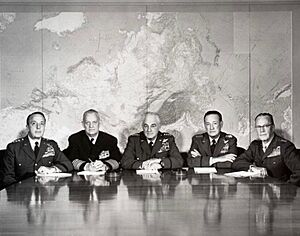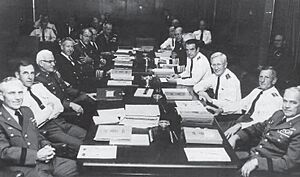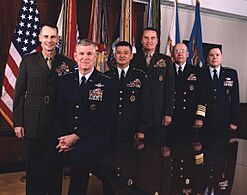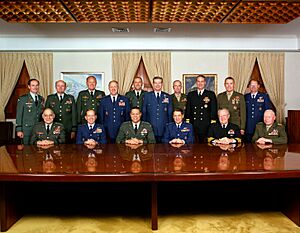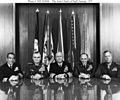Joint Chiefs of Staff facts for kids
Quick facts for kids Joint Chiefs of Staff |
|
|---|---|
| JCS | |
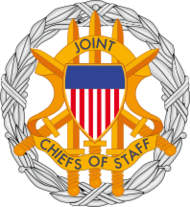
Joint Chiefs of Staff Identification Badge
|
|
| Role | Advisory board providing professional military advice to the secretary of defense and the president |
| Established in practice | 1942 |
| Constituting instrument | National Security Act of 1947 currently codified at 10 U.S.C. § 151 |
| Predecessor entities | Joint Board (1903–1942) |
| Members | |
| Chairman | Gen Dan Caine, USAF |
| Vice Chairman | ADM Christopher W. Grady, USN |
| Number of members | Eight |
| Administration | |
| Parent agency | U.S. Department of Defense |
| Staff organization | The Joint Staff (for the chairman and the vice chairman; the service chiefs and the National Guard Bureau chief have their own staffs assisting them) |
| Seat | The Pentagon |
The Joint Chiefs of Staff (JCS) is a group of the most important military leaders in the United States Department of Defense. They give advice to the president of the United States, the Secretary of Defense, and other important councils about military matters.
The JCS includes a Chairman (CJCS), a Vice Chairman (VJCS), and the top leaders from the Army, Marine Corps, Navy, Air Force, Space Force, and the chief of the National Guard Bureau. Each of these leaders also works directly for their own military department.
After a law called the Goldwater–Nichols Act in 1986, the Joint Chiefs of Staff do not directly command troops. Instead, the chain of command goes from the president to the Secretary of Defense, and then to the commanders who lead military operations around the world. This law also created the role of Vice Chairman. The Chairman is now the main military advisor to the president and other key councils.
The Joint Staff is a team of military personnel from all six branches. They work at The Pentagon and help the Chairman and Vice Chairman with their duties.
Contents
What the Joint Chiefs Do
After the Goldwater–Nichols Act in 1986, the Joint Chiefs of Staff no longer have direct control over military operations. Instead, the president and the Secretary of Defense give orders directly to the commanders in charge of different military regions.
Today, the main job of the Joint Chiefs is to make sure their military branches are ready with trained people, good plans, and proper training for the commanders to use. The chairman of the Joint Chiefs of Staff is also the top military advisor to the president and the Secretary of Defense. In this role, the Joint Chiefs help make important military decisions, working with the National Security Council and the Homeland Security Council.
Who are the Current Members?
| Position | Photograph | Name | Service | Serving since | Nominated by | Flag |
|---|---|---|---|---|---|---|
| Chairman of the Joint Chiefs of Staff | General J. Daniel Caine |
11 April 2025 | Donald J. Trump |  |
||
| Vice Chairman of the Joint Chiefs of Staff | Admiral Christopher W. Grady |
20 December 2021 | Joseph R. Biden |  |
||
| Chief of Staff of the Army | General Randy A. George |
21 September 2023 | Joseph R. Biden |  |
||
| Commandant of the Marine Corps | General Eric M. Smith |
22 September 2023 | Joseph R. Biden |  |
||
| Chief of Naval Operations | Admiral James W. Kilby Acting |
21 February 2025 | None |  |
||
| Chief of Staff of the Air Force | General David W. Allvin |
2 November 2023 | Joseph R. Biden |  |
||
| Chief of Space Operations | General B. Chance Saltzman |
2 November 2022 | Joseph R. Biden |  |
||
| Chief of the National Guard Bureau | General Steven S. Nordhaus |
2 October 2024 | Joseph R. Biden |  |
Coast Guard's Role
| Position | Photograph | Name | Service | Serving since | Nominated by | Flag |
|---|---|---|---|---|---|---|
| Commandant of the Coast Guard | Admiral Kevin E. Lunday Acting |
21 January 2025 | None |  |
The Coast Guard is part of the Armed Forces, but it usually works under the Department of Homeland Security. Only during times of war or national emergency can the president move it to the Department of the Navy.
The commandant of the Coast Guard is not an official member of the Joint Chiefs of Staff. However, they are sometimes invited to meetings and receive similar pay. Unlike the Joint Chiefs, the Commandant directly commands the Coast Guard.
History of the Joint Chiefs
Early Beginnings: The Joint Board
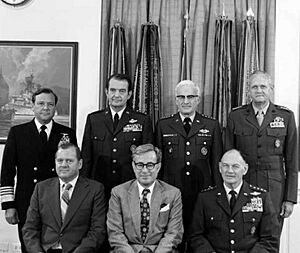
As the U.S. military grew after the American Civil War, it became hard for the Army and Navy to work together. They often disagreed, especially during the Spanish–American War.
To fix this, President Theodore Roosevelt created the Joint Army and Navy Board in 1903. This board was meant to plan joint operations and solve problems between the two services. However, it didn't have the power to make its decisions happen, so it didn't do much, even during World War I.
After World War I, the board was restarted in 1919 with new members and the ability to suggest ideas on its own. Still, it lacked the legal power to enforce its decisions.
World War II and the JCS Formation
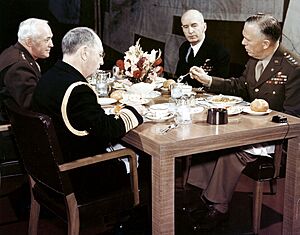
During World War II, U.S. President Franklin D. Roosevelt and British Prime Minister Winston Churchill created the Combined Chiefs of Staff (CCS) in 1942. This group would lead the joint U.S.-UK war effort.
The U.S. didn't have a military group like the British Chiefs of Staff Committee. So, Admiral William D. Leahy suggested a "unified high command" for the U.S. military. This led to the first official meeting of what would become the Joint Chiefs of Staff on February 9, 1942. Their goal was to coordinate the Army and Navy's efforts.
On July 20, 1942, Admiral Leahy became the "Chief of Staff to the Commander in Chief," overseeing the individual service chiefs.
The first members of the Joint Chiefs of Staff were:
| Name | Service | Position |
|---|---|---|
| Admiral William D. Leahy | USN | Chief of Staff to the Commander in Chief of the Army and Navy and Special Presidential Military Advisor |
| General George C. Marshall | USA | Chief of Staff of the United States Army (CSUSA) |
| Admiral Ernest J. King | USN | Commander in Chief of the United States Fleet and Chief of Naval Operations (COMINCH-CNO) |
| General Henry H. 'Hap' Arnold | USA | Chief of the Army Air Forces and Deputy Chief of Staff for Air |
Official Establishment: National Security Act of 1947
After World War II, the Joint Chiefs of Staff was officially created by the National Security Act of 1947. This law said the JCS would include a Chairman, the chiefs of the Army, the newly formed Air Force, and the Navy.
At first, the Commandant of the Marine Corps was only consulted on Marine matters and wasn't a full member. Later, a law change made the Commandant a full-time member of the JCS.
Changes from the Goldwater–Nichols Act of 1986
The Goldwater–Nichols Act of 1986 created the position of Vice Chairman. This role helps the Chairman with some duties, especially those related to managing resources.
Important Appointments and Changes
- General Colin L. Powell became the first African American Chairman of the JCS in 1989.
- General Charles Q. Brown Jr. was the second African American Chairman, taking the role on October 1, 2023. He was also the first African American to lead a service branch (Air Force Chief of Staff) in 2020.
- General Brown was later removed from his position by the Secretary of Defense on February 21, 2025.
- Admiral Lisa Franchetti became the first woman to serve on the JCS when she became Chief of Naval Operations on November 2, 2023. She was also removed from her position on February 21, 2025.
- These two removals marked the first time two members of the Joint Chiefs of Staff were dismissed from their senior military roles since the JCS was created in 1947.
- General Richard B. Myers was the first Vice Chairman to later become Chairman.
- General Peter Pace was the first Marine to serve as either Vice Chairman or Chairman.
Adding New Members
- The 2012 National Defense Authorization Act added the Chief of the National Guard Bureau to the Joint Chiefs of Staff. This was a very important change for the National Guard.
- The 2020 National Defense Authorization Act created the U.S. Space Force on December 20, 2019. The chief of space operations became an official member of the Joint Chiefs of Staff on December 20, 2020.
How the Joint Chiefs are Organized
The Chairman
The Chairman of the Joint Chiefs of Staff is the highest-ranking military officer in the United States Armed Forces. They are the main military advisor to the president. The Chairman leads the meetings and coordinates the work of the Joint Chiefs of Staff.
The Chairman outranks all other service chiefs but does not command them or their military branches. All combat commanders receive their orders directly from the Secretary of Defense.
Fleet Admiral William D. Leahy was the first person to hold a similar role, starting on July 20, 1942. The official position of "Chairman of the Joint Chiefs of Staff" was created later and first held by General of the Army Omar Bradley in 1949.
The Vice Chairman
The role of Vice Chairman of the Joint Chiefs of Staff was created by the Goldwater–Nichols Act of 1986. The Vice Chairman is the second highest-ranking member of the U.S. Armed Forces, after the Chairman. If the Chairman is not available, the Vice Chairman leads the meetings of the Joint Chiefs of Staff. They also help the Chairman with other duties.
The Vice Chairman became a full voting member of the JCS in 1992. The current Vice Chairman is Admiral Christopher W. Grady, who started his role on December 20, 2021. Admiral Grady is also currently acting as Chairman since February 21, 2025, until a new Chairman is confirmed.
Senior Enlisted Advisor
The Senior Enlisted Advisor to the Chairman of the Joint Chiefs of Staff (SEAC) gives advice on all matters related to enlisted service members across the military. They help develop training and education for non-commissioned officers and support the Chairman's duties.
Command Sergeant Major William Gainey was the first SEAC, starting on October 1, 2005. The current SEAC is Troy E. Black, who began his role on November 3, 2023.
The Joint Staff

Office of the Joint Chiefs of Staff Identification Badge
|
|
| Agency overview | |
|---|---|
| Formed | 1949 |
| Headquarters | The Pentagon |
| Employees | Approx. 1,500 |
| Agency executive |
|
| Parent agency | Department of Defense |
The Joint Staff (JS) is a military team located at The Pentagon. It includes personnel from all six armed services. They help the Chairman and Vice Chairman do their jobs. They also work closely with the Office of the Secretary of Defense and other military groups.
The chairman of the Joint Chiefs of Staff (CJCS) is helped by the director of the Joint Staff (DJS), a high-ranking officer. The DJS manages the Joint Staff, which has about equal numbers of officers from the Army, Navy, Marine Corps, Air Force, Space Force, and Coast Guard. These officers help the Chairman provide unified direction for all military forces to the Secretary of Defense.
The Joint Staff works on important military concepts like the "Joint Warfighting Concept" and "Joint All-Domain Command and Control" (JADC2). These ideas help the military operate together in all areas: air, land, sea, space, cyber, and the electromagnetic spectrum.
Departments of the Joint Staff
The Joint Staff has different departments, called directorates, where planning, policies, and other important functions happen:
- DOM – Directorate of Management (manages the staff)
- J1 – Personnel and Manpower (deals with military personnel)
- J2 – Intelligence (gathers and analyzes information)
- J3 – Operations (plans and directs military actions)
- J4 – Logistics (manages supplies and transportation)
- J5 – Strategic Plans and Policy (creates long-term plans and policies)
- J6 – Command, Control, Communications and Computers/Cyber (handles military communications and technology)
- J7 – Joint Force Development (develops training, education, and new ideas for joint forces)
- J8 – Force Structure, Resources, and Assessment (looks at military structure and resources)
Images for kids
-
Members of the Joint Chiefs of Staff at The Pentagon in 1958.
-
Members of the Joint Chiefs of Staff with President-Elect Jimmy Carter and Secretary of Defense Donald Rumsfeld on December 17, 1976.
-
Members of the Joint Chiefs of Staff during President Ronald Reagan Inaugural Parade on January 20, 1981.
-
Members of the Joint Chiefs of Staff render a salute for the late President Ronald Reagan at Andrews Air Force Base in 2004.
-
Members of the Joint Chiefs of Staff at Andrews Air Force Base during a funeral service ceremony for the late President Gerald Ford on December 26, 2006.
-
The Joint Chiefs of Staff at the Senate Armed Services Committee testimony in The Capitol Hill 2010.
See also
 In Spanish: Estado Mayor Conjunto de los Estados Unidos para niños
In Spanish: Estado Mayor Conjunto de los Estados Unidos para niños
- Chief of the Defence Force (Australia)
- Armed Forces Council (Canada)
- Chief of Defence Force (New Zealand)
- Chiefs of Staff Committee (United Kingdom)
- General Staff of the Armed Forces of the Russian Federation
- Joint Staff Department of the Central Military Commission (China)
- General Staff of the Israel Defense Forces
- Chief of Staff, Joint Staff (Japan)
- Joint Chiefs of Staff (South Korea)
- Chief of Defence Staff (India)
- Staff (military) – see Modern United States military usage for organization of Joint Staff (J1 through J8)












